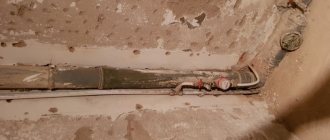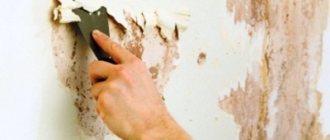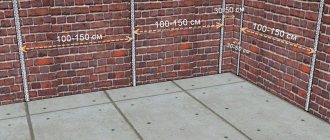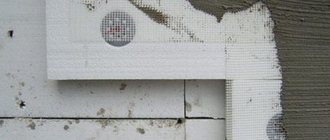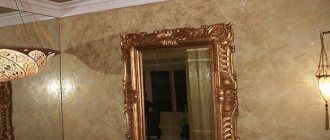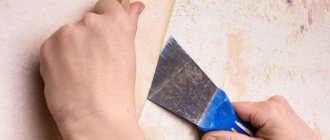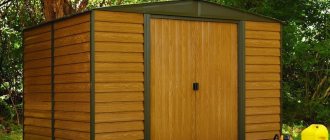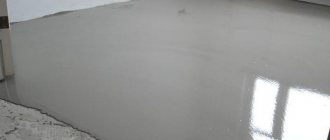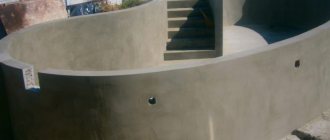Cement provides high strength and frost resistance, gypsum provides rapid strength gain. The option arises of mixing gypsum and cement and obtaining a high-strength binder with a rapid increase in strength. But it’s absolutely impossible to do this, and here’s why.
When mixing such a mixture with water (hydration), a reaction occurs between the aluminate components of clinker and semi-aqueous gypsum, which results in the formation of a high-sulfate form of calcium hydrosulfoaluminate - ettringite (another name for “cement bacillus”) . Ettringite (calcium hydrosulfoaluminate) greatly increases in volume during the process of gaining strength (hydration) and literally “tears” the cement stone.
That is why if you simply mix semi-aqueous gypsum with cement, after a short period of time the concrete based on such a complex binder (cement-gypsum) will simply collapse due to the development of the “cement bacillus” (formation and hydration of ettringite).
To prevent the formation of ettringite, it is necessary to add pozzolanic additives of natural (tripoli, opoka, diatomite) or artificial origin (acid blast furnace slag) to the gypsum + cement composition. The mechanism of action of pozzolanic (hydraulic) additives containing silica in active form is to reduce the concentration of calcium hydroxide in the gypsum-cement system, which allows almost completely avoiding the formation of ettringite (“cement bacillus”).
As a result, we get gypsum-cement-pozzolanic binder GCPV . Based on HCPV, it is possible to produce concrete with a strength of 15-40 MPa with frost resistance of 25-300 cycles and above. Modern GCPVs contain a set of binders, pozzolanic, plasticizing, thresholding and other additives and fillers carefully selected in terms of their quantitative composition. Such mixtures (for example, Stonemaker) make it possible to produce stone that hardens in less than 60 minutes and has a final strength of up to 40 MPa and frost resistance of up to 300 cycles, which allows it to be successfully used for the production of artificial stone for facade finishing.
If you do not want to deal with the preparation of GCPV yourself, with the risk of the formation of a “cement bacillus” and possible destruction of the stone, you can increase the strength of ordinary gypsum almost 10 times by using a special additive - gypsum strength activator SVV-500. This gypsum additive at a low consumption (up to 5% of the gypsum weight) allows you to increase the strength of the finished gypsum stone by an order of magnitude. You can also use the polycarboxylate hyperplasticizer MasterGlenium-115, which reduces the amount of mixing water by 35-40% (with the same fluidity of the mixture), which increases the strength of products made from such gypsum several times.
Example of a ready-to-use HCPV mixture:
— a mixture for the production of facade stone “Kamnedel facade”. This product can be purchased for the manufacture of decorative stone for facade cladding. It gains unmolding strength in 1 hour, but at the same time has frost resistance of 300 cycles and strength (40 MPa) comparable to the strength of cement-based stone.
— mixture for the production of decorative stone “Kamnedel Decor” (premium). We recommend it in the production of decorative stone for interior decoration. It gains unmolding strength in 40 minutes, providing a strength of at least 25 MPa.
Cement serves as the basis for creating a wide range of mortars intended for installation and finishing work. Gypsum is also used for the production of building mixtures, primarily plaster.
Cement mortars take a long time to gain strength, and gypsum hardens quickly, so there is a great temptation to mix these binders to obtain a composition that is convenient for installation. Let's figure out whether it is possible to mix gypsum with cement.
Use of gypsum for cement production
Cement is a multicomponent material, which includes:
- clayey rocks (loam, clay, shale, loess or loess-like loams);
- mineral rocks of the carbonate group (calcite, dolomite, limestone, chalk, marl).
If we consider the chemical composition of cement, it contains oxides of aluminum, silicon, magnesium, iron, and calcium.
During the production of cement, natural materials are dried, ground and mixed, after which the mixture is heated to high temperatures. The resulting clinker is ground again - the powder should be fine. Then various modifier additives are introduced to give the material certain properties.
Gypsum is added to all types of cement mixture to prevent rapid setting of the solution - this allows the material, ready for use, to be transported over the required distances. In addition, gypsum adds strength to the solution. The percentage of gypsum in cement is strictly defined - the volume of the additive is 3-6%, no more.
Video description
How to make a screed on expanded clay to reduce the load on the base, watch the video:
Ready-made formulations
Ready-made floor screed mortar is not sold in stores, but you can buy a dry mixture and simply dilute it with water according to the instructions, without choosing the proportions. This is very convenient: you don’t need to separately purchase plasticizer, cement and sand, sift it, carry it in buckets to a concrete mixer, and take into account its moisture content when adding water. But you will have to pay more for convenience. How much depends on the composition of the mixture, which may include a variety of improving additives. For example, fiberglass that reinforces the screed, or polystyrene foam granules that lighten it.
Such mixtures have many advantages over homemade ones.
- They are easy to knead with a construction mixer or a drill with an attachment in a container of suitable volume.
- Most of them can be laid in a thinner layer than required by construction requirements, without losing the strength of the created coating.
- They are self-leveling and require less effort to create a level, level surface.
Smooth, smooth and durable screed from the finished mixture Source materik-m.ru
Ettringite or "cement bacillus"
Is it possible to mix gypsum with cement to obtain a universal solution that can be applied in a thick layer and allows you to level a surface with noticeable defects in one go? Despite the fact that this approach is practiced by unscrupulous private craftsmen, adding gypsum or alabaster to the cement-sand mixture is strictly not recommended.
The aluminate components of cement react with gypsum when mixed with water, resulting in the formation of calcium hydrosulfoaluminate - ettringite. In ancient times, the appearance of ettringite was called “cement bacillus” - as the crystals gain strength, they greatly increase in volume and destroy the cement stone; it is impossible to resist this process.
Hydration (addition of water molecules) occurs not only during the preparation of the solution, but also under the influence of moisture on the material - for example, if the walls are plastered with a cement-gypsum mixture in a room with a high level of humidity or in the open air.
Purpose of the screed and requirements for it
A screed is a solid foundation created on the floor surface and serves as the basis for installing the finishing floor covering. It can be dry, semi-dry and wet, depending on the materials used and the technology of their installation. We are interested in the traditional wet screed, so called because it is created from a liquid, flowing solution, which becomes hard and durable as it dries. To prepare such a solution, you need a dry mixture for floor screed, which is mixed with water.
The type and thickness of the screed depend on its purpose.
- Leveling the original base.
The need for leveling may arise both to eliminate surface defects (pits, cracks, joints between slabs) and to bring it to a horizontal level. Often you have to solve both problems at the same time. The minimum thickness of the screed is 30 mm.
- Create a planned slope.
A screed with a slope allows you to organize water flow to drain holes, drains and gutters in “wet” rooms - bathrooms, showers, laundry rooms. At the lowest point, the thickness of the screed should be at least 20 mm.
When installing beacons, take into account the minimum permissible thickness of the screed at the drain hole Source dvervdom.ru
- Screed over a layer of heat and sound insulation.
The hardened screed mixture protects the fragile material from mechanical damage and allows the load from the weight of people, furniture, and equipment to be distributed as evenly as possible. Since under the screed in this case there is a movable and fragile layer of materials, it is made at least 40 mm thick.
- Hiding utility lines running along the floor.
The screed not only masks pipes and cables, but also protects them from damage. For the protection to be reliable, it must rise above the communications by at least 45 mm.
- Installation of a heated floor system.
In this case, the screed not only protects the water coil or electrical cable from damage, but also accumulates heat and distributes it evenly over the floor surface. The optimal thickness for it is 50-60 mm.
Water heated floor in a screed Source sk-resultat.ru
The maximum permissible maximum thickness of the screed is provided only for heated floors - it should not exceed 100 mm so that thermal energy is not wasted on heating the concrete. In other cases, they are guided by considerations of the optimal balance between cost and strength of the coating, always taking into account the permissible load on the floors.
Sad consequences
Unscrupulous performers use a solution of cement and gypsum for rough plastering of surfaces - the mixture is well laid in a thick layer and hardens quickly. This allows you to increase the speed of finishing work many times over, since without gypsum the cement-sand mixture has to be applied to concrete walls in layers with intermediate drying for several hours.
However, such plaster very quickly, within one to five days, becomes covered with a dense network of microcracks. If the material is applied to a red brick wall indoors, then the situation can be saved by a finishing layer of cement mortar without plaster or façade putty. In the case of concrete walls, this technology will not bring results.
Gypsum added to a cement-sand mortar sets quickly - the plaster becomes hard a few minutes after application, but it takes much longer to dry and is at the same time exposed to the “cement bacillus” due to the chemical reaction that occurs.
As a result, a plaster layer made from a mixture of gypsum and cement inside a dry room can last up to 5 years without collapsing, but on the façade of a building it will become unusable after the first winter. If a metal mesh is used for reinforcement, it will quickly begin to rust, since the plaster absorbs moisture due to the introduction of gypsum. Traces of rust will appear on the surface of the plastered wall.
Necessary tools and materials for plastering work
The quality of finishing directly depends on the tools used. Work equipment:
- Trowel (trowel).
- The rule is at least 1.5 meters long.
- Spatula - preferably 2 (narrow, wide).
- Half-grater.
- Level
- Plumb.
Finishing work is carried out both manually and using construction equipment. If it is necessary to lay a thick layer, beacon profiles are set and a construction mesh is attached. Metal corners are also used to create smooth outer corners. If there are shallow cracks, they are covered with a painting mesh with a thin layer of plaster.
Purchasing a concrete mixer is considered rational when building a private house. Since the volume is large, it is extremely difficult to manually mix the solution each time. In the case of renovation work, everything depends on the rental price.
Tools for plastering walls
Manually mixing a solution of sand, cement and water is difficult and time consuming - it is much faster to use a construction mixer. However, such equipment is expensive, and therefore it is optimal to buy a special attachment for a drill.
Application of gypsum-cement mixture
Before modifiers that could increase the adhesion of the solution began to be widely used, gypsum was added to the cement-sand mixture for plastering ceilings and upper slopes to simplify the work. As a result, it was necessary to regularly repair the ceilings, since after a few years the plaster could begin to fall off in pieces.
Cement and gypsum can be mixed to obtain an effective binder under one condition - pozzolanic additives, which contain silica in active form, are introduced into the mixture. These can be materials of natural origin (opka, diatomite, tripoli) or artificial (acid blast furnace slag). Silica reduces the concentration of calcium hydroxide in the mixture, thereby preventing the formation of ettringite.
Gypsum-cement-pozzolanic binder (GPVC) is used for the production of concrete. When manufacturing it, it is important to carefully observe the proportions of the components in order to avoid the risk of damage to the material by the “cement bacillus”.
Features of homemade and ready-made building mixtures
Ready-made plaster mixtures are not cheap, which is explained by the correct proportions of all components. In addition, in addition to the base, the composition includes various additives to give the coating the appropriate qualities. These are frost resistance, moisture resistance, increased adhesion, hardening period, etc.
Many finishers find it easier and more familiar to work with such materials than with homemade analogues. Customers prefer to use traditional mixtures, since their cost is significantly lower. Especially when it comes to large-scale work. In turn, homemade solutions can also be endowed with the necessary characteristics by adding simple components.
Use of gypsum for cement production
Cement is a multicomponent material, which includes:
- clayey rocks (loam, clay, shale, loess or loess-like loams);
- mineral rocks of the carbonate group (calcite, dolomite, limestone, chalk, marl).
If we consider the chemical composition of cement, it contains oxides of aluminum, silicon, magnesium, iron, and calcium.
During the production of cement, natural materials are dried, ground and mixed, after which the mixture is heated to high temperatures. The resulting clinker is ground again - the powder should be fine. Then various modifier additives are introduced to give the material certain properties.
Gypsum is added to all types of cement mixture to prevent rapid setting of the solution - this allows the material, ready for use, to be transported over the required distances. In addition, gypsum adds strength to the solution. The percentage of gypsum in cement is strictly defined - the volume of the additive is 3-6%, no more.
Ettringite or "cement bacillus"
Is it possible to mix gypsum with cement to obtain a universal solution that can be applied in a thick layer and allows you to level a surface with noticeable defects in one go? Despite the fact that this approach is practiced by unscrupulous private craftsmen, adding gypsum or alabaster to the cement-sand mixture is strictly not recommended.
The aluminate components of cement react with gypsum when mixed with water, resulting in the formation of calcium hydrosulfoaluminate - ettringite. In ancient times, the appearance of ettringite was called “cement bacillus” - as the crystals gain strength, they greatly increase in volume and destroy the cement stone; it is impossible to resist this process.
Hydration (addition of water molecules) occurs not only during the preparation of the solution, but also under the influence of moisture on the material - for example, if the walls are plastered with a cement-gypsum mixture in a room with a high level of humidity or in the open air.
Sad consequences
Unscrupulous performers use a solution of cement and gypsum for rough plastering of surfaces - the mixture is well laid in a thick layer and hardens quickly. This allows you to increase the speed of finishing work many times over, since without gypsum the cement-sand mixture has to be applied to concrete walls in layers with intermediate drying for several hours.
However, such plaster very quickly, within one to five days, becomes covered with a dense network of microcracks. If the material is applied to a red brick wall indoors, then the situation can be saved by a finishing layer of cement mortar without plaster or façade putty. In the case of concrete walls, this technology will not bring results.
Gypsum added to a cement-sand mortar sets quickly - the plaster becomes hard a few minutes after application, but it takes much longer to dry and is at the same time exposed to the “cement bacillus” due to the chemical reaction that occurs.
As a result, a plaster layer made from a mixture of gypsum and cement inside a dry room can last up to 5 years without collapsing, but on the façade of a building it will become unusable after the first winter. If a metal mesh is used for reinforcement, it will quickly begin to rust, since the plaster absorbs moisture due to the introduction of gypsum. Traces of rust will appear on the surface of the plastered wall.
Technique for calculating the amount of plaster mixture
Before plastering, you need to decide on the thickness of the layer to be laid. Measurements are taken at three (or more for accuracy) different points. The indicators are summed up and divided by the number of measurements. When using beacons, the layer thickness is comparable to the height of the slats.
Manufacturers of ready-mixes indicate on the packaging the average value per 1 m2. For Knauf Rotband plaster this is 8.5 kg per square meter of surface with a layer thickness of 10 mm. This average value must be multiplied by the calculated thickness of the future coating. The result is the mixture consumption per 1 m2 (in kg), which is multiplied by the entire treated area.
Typically, plaster is packaged in 30 kg bags and to determine how many are needed, the total consumption is divided by 30.
You only need to round up. In addition, in reality, more mixture will be needed, since the calculation does not allow taking into account all the existing irregularities and defects. Therefore, you need to make a reserve - 5-10% more.
Application of gypsum-cement mixture
Before modifiers that could increase the adhesion of the solution began to be widely used, gypsum was added to the cement-sand mixture for plastering ceilings and upper slopes to simplify the work. As a result, it was necessary to regularly repair the ceilings, since after a few years the plaster could begin to fall off in pieces.
Cement and gypsum can be mixed to obtain an effective binder under one condition - pozzolanic additives, which contain silica in active form, are introduced into the mixture. These can be materials of natural origin (opka, diatomite, tripoli) or artificial (acid blast furnace slag). Silica reduces the concentration of calcium hydroxide in the mixture, thereby preventing the formation of ettringite.
Gypsum-cement-pozzolanic binder (GPVC) is used for the production of concrete. When manufacturing it, it is important to carefully observe the proportions of the components in order to avoid the risk of damage to the material by the “cement bacillus”.
